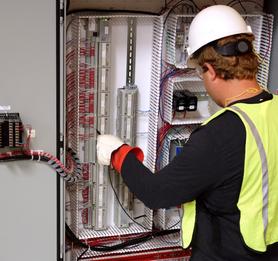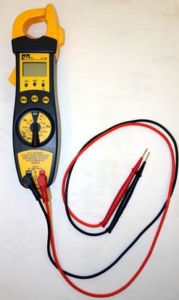In the process of designing and purchasing new equipment, the decision about what digital control voltage to choose for a facility to standardize on is often not clear cut. Manufacturers, control engineers, plant personnel and other decision makers can lean different directions with reasons ranging from specific design requirements to personal preference. There are a multitude of different options, but by and large the two most popular options are 24VDC (volts, direct current) and 120VAC (volts, alternating current). Both 24VDC and 120VAC powered devices are readily available and each have their advantages and drawbacks.
Starting with the more familiar of the two, 120VAC is the legacy control voltage. It is robust, reliable, and has a very broad existing installation base. With a higher potential voltage, voltage drop over long distances is seldom an issue and current requirements are smaller than lower voltage systems. 120VAC is often produced by a step-down transformer from 240V or 480V, and being a passive device, these transformers are very reliable.
However, 120VAC does have one large disadvantage — this level of voltage can be dangerous and potentially lethal. This risk is compounded by the fact that wide accessibility of 120VAC has desensitized us to the danger, leading many electricians and maintenance staff to underestimate the power of 120VAC. Although 120VAC poses little arc flash hazard when compared to common main power voltages such as 240V and 480V, there is still a very significant shock hazard. Because of high levels of access and disregard for safety measures, more people die in the United States from 120VAC shocks than any other voltage. Personnel don’t have to wear arc flash suits will working with this voltage in live panels, but they do need the proper shock resistant PPE (Personal Protective Equipment).
Unfortunately, the risk does not exist only at the control panels. It exists out on the plant floor at every piece of equipment wired to the control system. The risk is especially high on 120V control sensors. If the control system is on, voltage is always present in these locations even if the equipment is not running. The temptation is very great for personnel to adjust or reposition a sensor without turning off the control panel or putting on proper PPE. Often there is no immediate consequence to this action until an internal short or an exposed wire presents an increased shock risk.
Conversely, 24VDC’s main advantage over other voltage levels is safety. No arc flash hazards are present and the voltage is low enough that the shock hazard is almost negligible. But make no mistake, electricity is not a toy. If a perfect storm of bad conditions presents itself, it is still possible for 24VDC to be lethal. However this perfect storm will not be present in a properly designed control panel, so it is safe for personnel to work in such a panel without any additional electrical PPE equipment.
24VDC’s low voltage does come with some draw backs as well. Unlike 120V, 24V will suffer from voltage drop issues much sooner over shorter distances. The problem can be remedied with larger wire, but if we get a little more creative, there are other solutions available. If voltage drop problems show up after wires have been pulled, a technician can increase the voltage generated by the power supply. It is important to check your system’s specifications, but many DC control systems are rated from 10-30V. This allows you to squeeze a few more volts out of the DC power supply and still leave room for over-voltage conditions. If you have the opportunity to influence the system design, voltage drop issues can also be solved in the engineering phase. New PLC schemes are available with remote or distributed I/O architectures. In this setup, I/O racks are located nearby equipment then communicated back to the PLC via a protocol such as Ethernet/IP. This reduces the length of wire runs required, solving voltage drop issues and providing savings on installation costs in the process.
Another potential downside of 24V control voltage is that lower voltage leads to more current. Solenoids with high power requirements such as large motor starters will draw substantially more amps at 24VDC than 120VAC. In addition to higher amperage requirements, these solenoids are often sold at a premium over 120V solenoids.
With the pros and cons to each voltage laid out, it is worth mentioning that there is risk involved in mixing voltages. Effort should be made in all installations to standardize on one control voltage and use it for all sensors and devices. Though some engineers attempt to obtain the best of both worlds by placing 24VDC on inputs (sensors) for safety and 120VAC on outputs (solenoids and devices) to avoid voltage drop and high current difficulties, this design style should be avoided. In addition to creating more points of failure, mixing and matching control voltages creates a headache for future personnel trying to sort through which devices are on which voltages.
At the end of the day, decision makers need to review comments and concerns from all involved parties when faced with the choice of control voltage. Often if new equipment is being placed into an existing plant standardized 120VAC, it makes the most sense to remain consistent throughout, continue to use 120VAC in equipment upgrades and provide additional electrical safety training to personnel. Most greenfield plants elect to utilize the emerging 24VDC as a plant wide standard. In between the two ends of the spectrum, this decision requires a lot of thought and careful planning.Jim Schmelzle, Service Technician
When working with electrical panels, a “lock out-tag out” procedure is an easy way to quickly reduce hazards and should always be enforced. If possible, de-energize circuits prior to working on or near them. Unfortunately, when working with control panels in a manufacturing facility that is in production, this is not always an option. In this case, wearing the correct protective gear appropriate for the panel rating is very important.
The Importance of Protective Gear
 Wearing flame resistant clothing, removing watches and other jewelry, wearing insulated gloves, safety glasses or a face shield, and using insulated tools are all great protective ware. So, how much and what kinds of protective gear should be worn for each panel rating? The best way to answer this question is to research safety standards and stay up-to-date with the most recent standard releases found in NFPA 70E Article 130.
Wearing flame resistant clothing, removing watches and other jewelry, wearing insulated gloves, safety glasses or a face shield, and using insulated tools are all great protective ware. So, how much and what kinds of protective gear should be worn for each panel rating? The best way to answer this question is to research safety standards and stay up-to-date with the most recent standard releases found in NFPA 70E Article 130.
There are 5 hazard risk categories that require different protective gear (category 0 through category 4). According to NFPA 70E Article 130, a category 0 task will require you to wear long sleeves and long pants of a non-melting material along with safety glasses and hearing protection. Operating a circuit breaker with covers on it would fall into category 0.
Category 1 will require Arc-rated clothing of at least level 4 along with hard hat, safety glasses, hearing protection, insulated leather gloves, leather work shoes and an arc rated face shield. Voltage testing of live circuits under 240 V will fall under a category 1 task. It would also require the use of insulated hand tools. For information about protective gear for other categories, use Article 130 referred to above.
Working with Live Circuits
 Always make sure to visually inspect all tools before using them on a live circuit. Also make sure the meter is correctly rated for the circuit you are testing. Connect the ground lead first then the hot lead. When finished, remove the hot lead first then remove the ground lead. It is also a good idea to hang or rest the meter in a secure location and avoid holding it in your hand in case of a meter fault.
Always make sure to visually inspect all tools before using them on a live circuit. Also make sure the meter is correctly rated for the circuit you are testing. Connect the ground lead first then the hot lead. When finished, remove the hot lead first then remove the ground lead. It is also a good idea to hang or rest the meter in a secure location and avoid holding it in your hand in case of a meter fault.
Communication and Coordination
Communicating and coordinating with the people in your work environment to make the area as safe as possible is essential. Making people aware of the work you are doing in that area. Putting together a plan and discussing it with others on-site is a good way to ensure that everyone is cognizant of what is happening. You have to think about everyone that could come in contact with the work being performed. Use orange cones and caution tape to guide people away from hazardous work zones.
Safety is one of the most important issues of working with electricity on any site. A little planning and attention to safety during implementation is all it takes to make a safe work environment.

